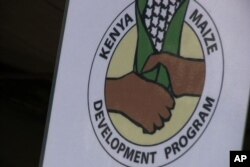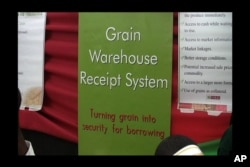The U.N. Food and Agriculture Organization says most people go hungry because of high domestic food prices, low incomes, high unemployment and access to food. That is why Paul Guenette, technical managing director for the non-profit group ACDI/VOCA, believes it's important to help small farmers achieve greater crop yields.
"When people can produce enough food hunger is going to go away."
Guenette's organization, ACDI/VOCA, works to help poor farmers develop sustainable agriculture. He says governments are increasingly supportive of sustainable farming, such as ACDI/VOCA's maize program in Kenya.
He says his organization now has 100,000 farmer demonstration fields happening in Kenya, and that some farmers in Kenya have doubled or tripled the amount of maize they produce.
John Hoddinott, a senior research fellow at the nonprofit International Food Policy Institute, says sustainable farming directly benefits the poor.
"For many poor people in Africa and elsewhere," he says, "interventions which actually improve food production also benefit those individuals in an income sense. Small farmers who can produce more maize and rice on the land they have, not only are producing more food, ... they are also increasing their own incomes."
The world's changing diet also affects food prices. As incomes improve for people in China and India, they may spend more money on beef, fish and poultry. Analysts say demand for such high protein animal products increases demand for grains, leading to higher prices for staples such as barley, corn and wheat.
Still, change can offer opportunity, according to Margaret Zieglar, deputy director at the nonprofit Congressional Hunger Center. "For the first time," she says, "it really seems world leadership is focused on world hunger for the first time in decades. We are believing this is a moment to seize in order to focus political will and to increase funding for programs that work."
Zieglar says with improved farming technology and efficiency, even poor farmers can be competitive in the marketplace. She says poor farmers can diversify their crops, and grow higher value crops that can be exported to earn money.
Paul Guenette of ACDI/VOCA says that farmers in developing countries also need improved infrastructures to get their products to market, and better roads are just one part of the complete picture. "The food systems have to work," he says. "The grocery stores, the farmer's field, the fertilizer input systems, the banking sectors, the political environment for economic investment."
When poor farmers are given training and work collectively, Guenette says, they become more commercially competitive, improving their efficiency and their access to the marketplace.
"Money in Motion" is VOA's webcast exploring the worlds of commerce, business and their impact on people. Watch all of the webisodes by going here








